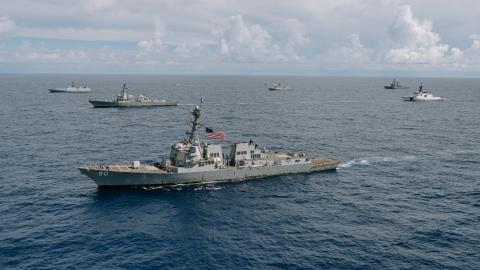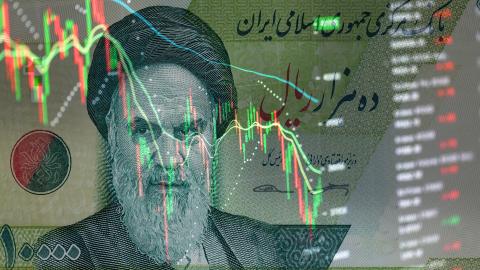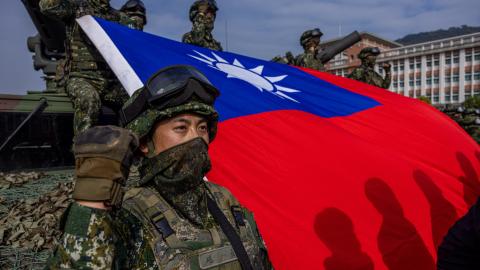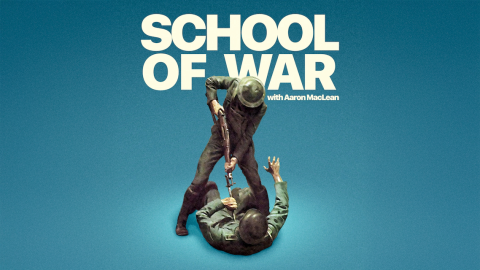Recent clashes in Ukraine, Syria and the South China Sea indicate the magnitude of the challenges that revisionist powers Russia and China present to the Western powers. Using “hybrid” techniques, Russian and Chinese policymakers have skillfully mixed military and non-military tactics to achieve geopolitical gains at the expense of the United States and its partners and allies.
Despite major dissimilarities in terms of their national assets, methods, objectives and world visions, Russia and China present some comparable challenges to global security. In particular, both authoritarian states have applied various military, paramilitary, legal, economic and information tools in the western Pacific and Eurasia to expand their regional influence, divide potential opponents and otherwise seize the strategic initiative.
The West has yet to develop an effective response to what can be variously termed their “asymmetric,” “sub-conventional,” “hybrid,” “non-linear,” “ambiguous,” “unrestricted,” unconventional” and “next-generation warfare” tactics. Chinese and Russian instruments of influence have included economic coercion, proxy actions, sophisticated propaganda and exploitation of ethnic and other societal tensions. The aggregate effect of these tools has presented a potent hybrid mix that other countries have found difficult to counter.
For example, Moscow’s actions in Ukraine and Beijing’s moves in the South China Sea have deliberately fallen below the threshold necessary to trigger collective defense countermeasures by the United States and its allies. Through such “salami slicing” tactics, China has gradually expanded its control over contested islands in the South China Sea. Like Moscow in eastern Ukraine, Beijing has disrupted the status quo and presented the world with a fait accompli, in this case by declaring an air identification zone and, more recently, by constructing artificial islands that could provide forward operating bases for the Chinese military.
A combination of aversion and opportunity fuels Russian and Chinese revisionism. The leaders of both countries are dissatisfied with the US-led “global order” – embodied in various rules and institutions such as the international financial institutions established immediately after World War II and the network of US-led security alliances in Europe and Asia. They have offered a range of objections to current practices, but assume that the current global order unduly constrains power and prestige for Moscow and Beijing. Another shared reason for revisionist stances is that both great powers are surrounded by weaker and divided countries, presenting an attractive security vacuum.
Furthermore, Russian leaders resent their limited influence on European security and economic developments due to their exclusion from the continent’s dominant institutions, NATO and the European Union. Likewise, Chinese leaders see enervating US alliances in Asia as essential for expanding their regional power and influence.
The governments of China and Russia have each supported norms, such as resistance to Western conceptions of human rights and limited sovereignty, offensive to Western values and interests. They are also building multinational institutions, such as the Moscow-centered Eurasian Economic Union and their co-led Shanghai Cooperation Organization, that exclude any meaningful Western input. They hope that these structures, including those associated with the BRICS bloc, will eventually provide the multilateral foundation of an alternative world order.
China, like Russia, is a great power with enormous multiple dimensions of military strength. Like many Russians who maintain that Ukraine should be under Moscow’s control for historical, cultural and geopolitical considerations, many Chinese have territorial grievances and ambitions that fuel expansionist tendencies. While Beijing has long claimed that the South China Sea should fall under its control due to considerations of history and geography, it has only been in recent years that China has attained the coercive power to press its claims.
In terms of national assets, China and Russia are both military great powers. In particular, they have nuclear weapons, powerful conventional forces, and an ample portfolio of sub-conventional and non-kinetic resources. Whereas the Kremlin has employed paramilitary ground forces without insignia in Ukraine, Beijing has been employing naval militia posing as fishermen and other “civilian’ maritime vessels for coercive purposes in the Pacific.
While China does not have formal military allies and foreign military bases as Russia does, the nation’s economic clout and other assets have persuaded many Asian states to do whatever they can to avoid confronting Beijing. Instead, they lobby Washington behind-the-scenes to stand up to China on their behalf.
Whereas China has much greater overall economic power than Russia, the Russian Federation has a larger economy than any of the other former Soviet republics, enhancing Moscow’s leverage over these states. Beijing and Moscow have built deep economic relationships with their surrounding states that give their partners strong incentives to avoid confrontations. Many neighboring countries of Russia and China depend heavily on sustaining access to their markets or have deep commercial ties with them. However, both Russia and China are constrained by globalization, which creates reciprocal interdependencies and offers many alternative economic partners to even neighboring states. Their communist-era economic autarky has long eroded.
One clear difference between Russia and China is that only Moscow has been formally annexing new territories, supporting armed proxies in neighboring countries, and regularly making implicit and explicit nuclear threats against other states. For almost a decade, Russian leaders have been threatening European countries with conventional and even nuclear strikes if they host US missile defenses or take other actions deemed to threaten Russian security.
Chinese leaders are more subtle in their language, eschewing explicit military threats and only suggesting negative implications – that others’ actions will threaten regional stability. In the Asia-Pacific region, though China’s activities are considerably greater in scale than those of its regional rivals and Beijing’s agenda is openly revisionist compared with the status quo orientation of its neighbors, the country is but one of several involved in reclaiming land and erecting military facilities in disputed territories, making it more difficult for the United States and other third parties to single out Beijing’s bad behavior.
Most worrisome, despite the publicity surrounding Russian actions in Ukraine and now Syria, in many respects, China is better positioned to employ hybrid tactics successfully across a wider range of scenarios than Russia. For example, whereas NATO is the world’s most powerful military alliance and can partner with a European Union rich in civilian power, China faces a divided Asian security landscape without a cohesive countervailing coalition against the revisionist power. In the past two years, the Kremlin achieved some short-term successes but at the expense of long-term strategic isolation and containment. Beijing, on the other hand, has seen its strategic influence grow, both in the Asia-Pacific and globally, without the formation of a powerful regional coalition as a counterweight.
The Pentagon has launched a long-term effort to develop new defense technologies and concepts designed to “offset” China’s and Russia’s growing military power, but progress in negating their sub-conventional challenges has been slower. Any effective Western approach to managing hybrid challenges must appreciate the similarities and differences in how Beijing and Moscow pursue hybrid tactics. For example, Russia is more vulnerable to targeted economic sanctions and counter media-messaging. Nonetheless, the West should not become so preoccupied with Russian revanchism as to overlook China’s superior potential, if not yet propensity, to cause trouble.
















